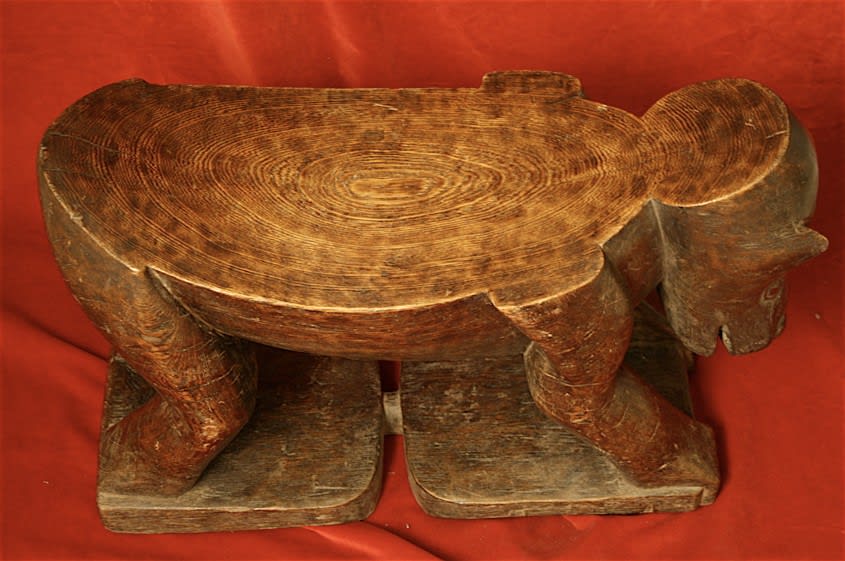Kuba Zoomorphic Stool, 20th Century CE
Wood
pf.1495 (LSO)
This dynamic zoomorphic sculpture of an unidentified animal (perhaps a dog, hippopotamus or a fictional creature based upon some mythological story) with head lowered, upon an unusual bipartite base. The...
This dynamic zoomorphic sculpture of an unidentified animal (perhaps a dog, hippopotamus or a fictional creature based upon some mythological story) with head lowered, upon an unusual bipartite base. The legs are flexed and powerful, the head elongated and the body corpulent with a curved abdomen. This is accentuated by the back, which is strongly inwardly curved and highly polished from repeated rubbings. While resembling a seat, it is in fact a divination piece, which was rubbed with special friction tools in an attempt to read the future and perhaps influence it.
The Kuba are a large Congolese tribe comprised of various smaller entities including the Bushoong, Ngeende, Kete, Lele, Binji, Dengese, Mbuun and Wongo peoples. They are quasi-autonomous within the Kuba polity but are related genetically and artistically. Their social systems are hereditary monarchies headed by the “Mushenge” (Nyim), who is responsible for the spiritual and material wealth of his people. The kingdom was founded in the early 17th century by Shyaam a-Mbul a Ngoong-Shyaam who united disparate groups under his authority. Their religion was based upon a creator god named MBoom, while more immediate concerns were the province of a being named Woot who was involved with more tangible issues; the Kuba are also known as the Children of Woot.
Their religious system was based partly around divination, using objects – such as this – called Itumbwa, in order to identify Ngesh (malevolent spirits). Various forms are known, although the pieces are usually zoomorphic and sometimes bicephalous – this was believed to represent increased vigilance and awareness. It was used in combination with a small wooden instrument that was moistened with oil and rubbed on the polished back of the animal, its movements and whether or not (or where) it sticks being interpreted as the answers to questions being asked at the time. This tradition has considerable antiquity, and may have been introduced by the Kete people in the 15th of 16th century.
This is a well-used and well-preserved example, and a worthy addition to any serious collection of African art.
The Kuba are a large Congolese tribe comprised of various smaller entities including the Bushoong, Ngeende, Kete, Lele, Binji, Dengese, Mbuun and Wongo peoples. They are quasi-autonomous within the Kuba polity but are related genetically and artistically. Their social systems are hereditary monarchies headed by the “Mushenge” (Nyim), who is responsible for the spiritual and material wealth of his people. The kingdom was founded in the early 17th century by Shyaam a-Mbul a Ngoong-Shyaam who united disparate groups under his authority. Their religion was based upon a creator god named MBoom, while more immediate concerns were the province of a being named Woot who was involved with more tangible issues; the Kuba are also known as the Children of Woot.
Their religious system was based partly around divination, using objects – such as this – called Itumbwa, in order to identify Ngesh (malevolent spirits). Various forms are known, although the pieces are usually zoomorphic and sometimes bicephalous – this was believed to represent increased vigilance and awareness. It was used in combination with a small wooden instrument that was moistened with oil and rubbed on the polished back of the animal, its movements and whether or not (or where) it sticks being interpreted as the answers to questions being asked at the time. This tradition has considerable antiquity, and may have been introduced by the Kete people in the 15th of 16th century.
This is a well-used and well-preserved example, and a worthy addition to any serious collection of African art.
